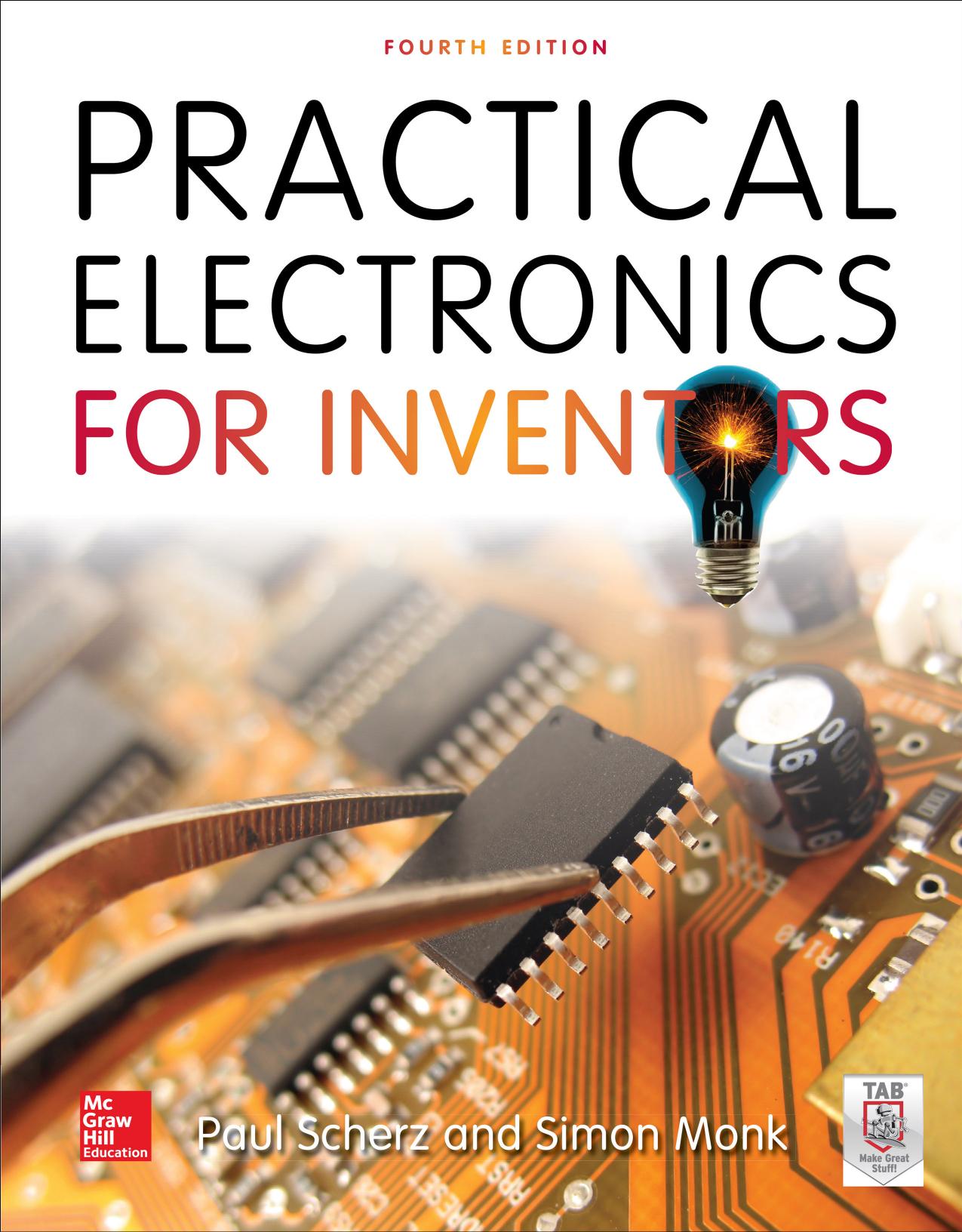Practical Electronics for Inventors by Paul Scherz

Author:Paul Scherz
Language: eng
Format: epub, pdf
Tags: -
Publisher: McGraw-Hill Education
Published: 2012-12-26T16:00:00+00:00
FIGURE 5.12 (a) This circuit can be used to identify the proper connections and polarity and then to drive the laser diode for testing purposes. Here a 0- to 10-VDC supply with current-limiting resistor is in series with the diode. If your power supply has a current limiter, set it at 20 to 25 mA to start. You can always increase it later. R2 limits the maximum current. If you know the specs for your diode, this is a good idea (and to protect your power supply, too). You can always reduce its value if your laser diode requires more than about 85 mA (with R2 = 100 Ω). (b) This runs on a (wall adapter) power supply from 6 to 9 V. There is heavy capacitive filtering in this circuit. Changes would be needed to enable this circuit to be modulated at any reasonable rate. Note that C4 is estimated; also, an LM341 shunt regulator set up as a 2.5-V reference could replace the 2.5-V zener. (c) The resistor value depends on your specific laser diode current requirements. Power is provided by a 5.5- to 9-VDC battery. For the resistor, a small 10-Ω carbon resistor in series with a precision 20-Ω adjustable resistor can be used. It’s a good idea to place three ordinary diodes in series instead of a laser diode, then measure the current through them and adjust the resistor until the necessary current level is reached, in this case 50 to 60 mA. You can turn up the current, never exceeding your diode’s maximum limit. The dim glow will increase in intensity, but at some point a distinctive step in intensity is reached. (d) This circuit is from an inexpensive laser pointer. It includes some capacitive filtering, as well as a power-adjust pot R1. Unlike the previous circuit, this one doesn’t have any absolute reference, so power output will be dependent on the battery voltage to some extent. It’s possible to modulate this module at a reasonable frequency by removing or greatly reducing the value of the filter capacitor C1.
DRIVE CIRCUIT PRECAUTIONS
Even with a suitable drive circuit, watch out for intermittent or unreliable connections between the laser diode and the drive circuit. An intermittent contact in the photodiode feedback circuit will usually destroy a laser diode. Even if a power-control potentiometer’s wiper breaks contact with the resistive element, there can be problems. Also, never use a switch or relay to make or break the connection between the drive circuit and the laser diode. The following are some other laser diode precautions:
Power measurement: It’s not safe to assume that the optical power output of a laser diode will match what’s stated in the manufacturer’s minimum-maximum data—each diode will have a unique operating characteristic as a result of manufacturing tolerances. For accuracy, you must measure the output with an optical power meter or a calibrated photodiode. Remember, once the laser diode is past the threshold point, stimulated emission is achieved and the optical output increases significantly for a small increase in forward current.
Download
Practical Electronics for Inventors by Paul Scherz.pdf
This site does not store any files on its server. We only index and link to content provided by other sites. Please contact the content providers to delete copyright contents if any and email us, we'll remove relevant links or contents immediately.
| Circuits | Digital Design |
| Electric Machinery & Motors | Electronics |
| Fiber Optics | Networks |
| Superconductivity |
Whiskies Galore by Ian Buxton(40877)
Introduction to Aircraft Design (Cambridge Aerospace Series) by John P. Fielding(32389)
Small Unmanned Fixed-wing Aircraft Design by Andrew J. Keane Andras Sobester James P. Scanlan & András Sóbester & James P. Scanlan(32168)
Craft Beer for the Homebrewer by Michael Agnew(17489)
Turbulence by E. J. Noyes(7108)
The Complete Stick Figure Physics Tutorials by Allen Sarah(6675)
Kaplan MCAT General Chemistry Review by Kaplan(6099)
The Thirst by Nesbo Jo(5835)
Bad Blood by John Carreyrou(5816)
Learning SQL by Alan Beaulieu(5465)
Weapons of Math Destruction by Cathy O'Neil(5094)
Man-made Catastrophes and Risk Information Concealment by Dmitry Chernov & Didier Sornette(4804)
iGen by Jean M. Twenge(4727)
Digital Minimalism by Cal Newport;(4661)
Life 3.0: Being Human in the Age of Artificial Intelligence by Tegmark Max(4555)
Audition by Ryu Murakami(4140)
Electronic Devices & Circuits by Jacob Millman & Christos C. Halkias(4085)
1,001 ASVAB Practice Questions For Dummies by Powers Rod(4071)
Pale Blue Dot by Carl Sagan(4055)
